
Illustrative Math Alignment: Grade 7 Unit 8
Probability and Sampling
Lesson 5: More Estimating Probabilities
Use the following Media4Math resources with this Illustrative Math lesson.
| Thumbnail Image | Title | Body | Curriculum Topic |
|---|---|---|---|

|
Math Video Collection: Texas Instruments Tutorial Videos |
OverviewThis collection aggregates all the math videos and resources in this series: Texas Instruments Tutorial Videos. There are a total of 266 resources. This collection of resources is made up of downloadable MP4, transcripts, and other resources files that you can easily incorporate into a presentation.
|
Rational Expressions, Sequences, Series, Polynomial Functions and Equations, Graphs of Quadratic Functions, Quadratic Equations and Functions, Solving Systems of Equations, Trig Expressions and Identities, Probability, Geometric Constructions with Triangles, Composite Functions, Geometric Constructions with Angles and Planes, Distance Formula, Data Analysis, Slope, Special Functions, Trigonometric Functions, Graphs of Exponential and Logarithmic Functions, Radical Functions and Equations, Rational Functions and Equations, Slope-Intercept Form, Coordinate Systems, Graphs of Linear Functions, Inequalities, Matrix Operations and Midpoint Formula |

|
Math Examples Collection: Probability | OverviewThis collection aggregates all the math examples around the topic of Probability. There are a total of 28 Math Examples. This collection of resources is made up of downloadable JPG images that you can easily incorporate into your lesson plans. |
Probability |
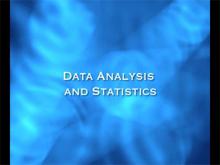
|
VIDEO: Algebra Nspirations: Data Analysis and Probability | VIDEO: Algebra Nspirations: Data Analysis and Probability
TopicData Analysis |
Data Analysis and Data Gathering |
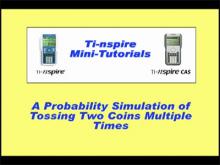
|
Closed Captioned Video: A Probability Simulation 3 | Closed Captioned Video: A Probability Simulation 3
In this TI Nspire tutorial, the Spreadsheet and Statistics windows are used to create a probability simulation of tossing two coins. This video supports the TI-Nspire Clickpad and Touchpad. This Mini-Tutorial Video includes a worksheet. . |
Probability |

|
Closed Captioned Video: Algebra Nspirations: Data Analysis and Probability | Closed Captioned Video: Algebra Nspirations: Data Analysis and Probability
What are the two meanings of statistics? What does it really mean that an event has a 50% probability of occurring? Why are data analysis and probability always taught together? Written and hosted by internationally acclaimed math educator Dr. Monica Neagoy, this video answers these questions and addresses fundamental concepts such as the law of large numbers and the notion of regression analysis. Both engaging investigations are based on true stories and real data, utilize different Nspire applications, and model the seamless connection among various problem representations. Concepts explored: statistics, data analysis, regression analysis. |
Data Analysis and Data Gathering |
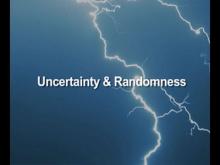
|
Closed Captioned Video: Algebra Nspirations: Data Analysis and Probability, 1 | Closed Captioned Video: Algebra Nspirations: Data Analysis and Probability, Segment 1
In this Investigation we explore uncertainty and randomness. This video is Segment 1 of a 4 segment series related to Data Analysis and Probability. Segments 1 and 2 are grouped together. |
Data Analysis and Data Gathering |
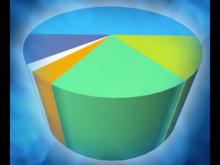
|
Closed Captioned Video: Algebra Nspirations: Data Analysis and Probability, 3 | Closed Captioned Video: Algebra Nspirations: Data Analysis and Probability, Segment 3
In this Investigation we look at real-world data involving endangered wolf populations. This video is Segment 3 of a 4 segment series related to Data Analysis and Probability. Segments 3 and 4 are grouped together. |
Data Analysis and Data Gathering |
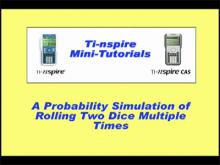
|
Closed Captioned Video: Probability Simulation 1 | Closed Captioned Video: Probability Simulation 1
In this TI Nspire tutorialthe Spreadsheet and Statistics windows are used to create a probability simulation of tossing two dice. This video supports the TI-Nspire Clickpad and Touchpad. This Mini-Tutorial Video includes a worksheet. . |
Probability |
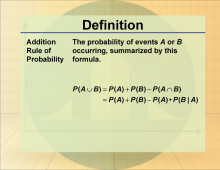
|
Definition--Statistics and Probability Concepts--Addition Rule of Probability | Addition Rule of ProbabilityTopicStatistics and Probability DefinitionThe Addition Rule of Probability is a key concept in statistics that helps in understanding the interaction between different events. DescriptionThe Addition Rule of Probability is crucial in the field of statistics because it allows us to make informed decisions based on the relationships between variables. For instance, in real-world applications, this concept is essential in various fields such as economics, social sciences, and health studies. Understanding how events affect each other can lead to better predictions and strategies. |
Data Analysis |

|
Definition--Statistics and Probability Concepts--Bivariate Data | Bivariate DataTopicStatistics and Probability DefinitionBivariate data involves the analysis of two variables to determine relationships between them. DescriptionBivariate data is essential in statistics as it allows for the exploration of relationships between two variables, such as height and weight. This analysis is used in various fields, including economics, biology, and social sciences, to understand correlations and causations. For example, a scatter plot can be used to visually represent bivariate data, helping to identify trends or patterns. |
Data Analysis |

|
Definition--Statistics and Probability Concepts--Causation | CausationTopicStatistics and Probability DefinitionCausation refers to the relationship between two events where one event is affected by the other. DescriptionCausation is a fundamental concept in statistics that distinguishes between correlation and causation. Understanding causation is vital in fields like medicine and social sciences to establish cause-effect relationships. For example, clinical trials are designed to establish causation between treatments and outcomes. Grasping causation is important for students to critically evaluate research findings and understand the implications of statistical analyses. |
Data Analysis |
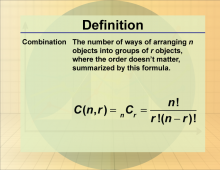
|
Definition--Statistics and Probability Concepts--Combination 1 | Combination 1TopicStatistics and Probability DefinitionA combination is a selection of items from a larger pool where order does not matter. DescriptionCombinations are used in probability to determine the number of ways to select items from a set, which is crucial in fields like cryptography and game theory. The formula for combinations is
where n is the total number of items, and r is the number of items to choose. |
Data Analysis |

|
Definition--Statistics and Probability Concepts--Combination 2 | Combination 2TopicStatistics and Probability DefinitionA combination is a selection of items from a larger pool where order does not matter. DescriptionCombinations are used in probability to determine the number of ways to select items from a set, which is crucial in fields like cryptography and game theory. The formula for combinations is
where n is the total number of items, and r is the number of items to choose. |
Probability |
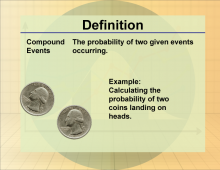
|
Definition--Statistics and Probability Concepts--Compound Events | Compound EventsTopicStatistics and Probability DefinitionA compound event in probability is an event that consists of two or more simple events. DescriptionCompound events are important in probability as they allow for the calculation of the likelihood of multiple events occurring together, which is applicable in areas like risk assessment and decision-making. Understanding compound events helps students develop skills to analyze complex scenarios and calculate probabilities effectively. |
Probability |
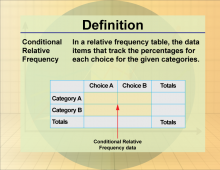
|
Definition--Statistics and Probability Concepts--Conditional Relative Frequency | Conditional Relative FrequencyTopicStatistics and Probability DefinitionConditional relative frequency is the ratio of the frequency of a subset of data to the frequency of a condition. DescriptionConditional relative frequency is crucial in analyzing categorical data, helping to understand the distribution of data under specific conditions. For example, the frequency of students who pass a test given they have attended all classes is a conditional relative frequency. Understanding this concept helps students interpret data in surveys and experiments more accurately. |
Data Analysis |
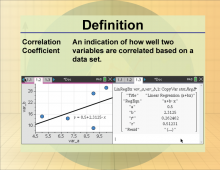
|
Definition--Statistics and Probability Concepts--Correlation Coefficient | Correlation CoefficientTopicStatistics and Probability DefinitionThe correlation coefficient is a measure that quantifies the degree to which two variables are related. |
Data Analysis |
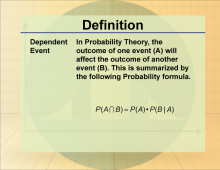
|
Definition--Statistics and Probability Concepts--Dependent Event | Dependent EventTopicStatistics and Probability DefinitionA dependent event is an event whose outcome is influenced by the outcome of a preceding event. |
Probability |

|
Definition--Statistics and Probability Concepts--Independent Event | Independent EventTopicStatistics and Probability DefinitionAn independent event is an event whose outcome is not affected by the outcome of another event. DescriptionIndependent events are a key concept in probability, where the occurrence of one event does not influence another. This principle is applied in various fields, such as quality control, where the failure of one product does not affect others. Understanding independent events is essential for students to accurately calculate probabilities and analyze situations where events occur without influencing each other. |
Probability |
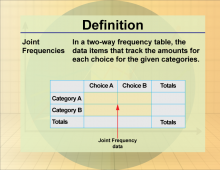
|
Definition--Statistics and Probability Concepts--Joint Frequencies | Joint FrequenciesTopicStatistics and Probability DefinitionJoint frequencies refer to the counts of occurrences for combinations of two categorical variables. DescriptionIn statistics, joint frequencies are used to analyze the relationship between two categorical variables, often displayed in a contingency table. This analysis is vital in fields such as market research, where understanding the joint distribution of consumer preferences can inform product development. For students, learning about joint frequencies is important for interpreting data from surveys and experiments, allowing them to explore relationships between variables effectively. |
Data Analysis |
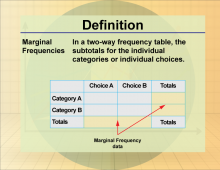
|
Definition--Statistics and Probability Concepts--Marginal Frequencies | Marginal FrequenciesTopicStatistics and Probability DefinitionMarginal frequencies are the totals of rows or columns in a contingency table, representing the sum of joint frequencies for each category. DescriptionMarginal frequencies provide insight into the overall distribution of each variable in a dataset. They are crucial in fields like epidemiology, where understanding the marginal distribution of diseases can inform public health strategies. For students, comprehending marginal frequencies is essential for summarizing data and drawing conclusions about the prevalence of certain characteristics within a population. |
Data Analysis |
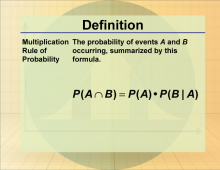
|
Definition--Statistics and Probability Concepts--Multiplication Rule of Probability | Multiplication Rule of ProbabilityTopicStatistics and Probability DefinitionThe multiplication rule of probability is used to find the probability of two independent events both occurring. DescriptionThe multiplication rule is essential in probability for calculating the likelihood of multiple independent events occurring together. This rule is applied in fields such as genetics, where the probability of inheriting multiple traits is determined. For students, understanding the multiplication rule is crucial for solving problems involving the probability of compound events and for developing a deeper understanding of probability theory. |
Data Analysis |

|
Definition--Statistics and Probability Concepts--Permutation 1 | Permutation 1TopicStatistics and Probability DefinitionA permutation is an arrangement of items in a specific order. DescriptionPermutations are used in probability and combinatorics to determine the number of ways to arrange a set of items, which is crucial in fields like cryptography, where secure codes are generated. The formula for permutations is |
Data Analysis |
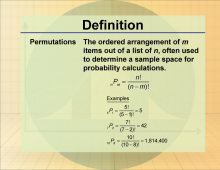
|
Definition--Statistics and Probability Concepts--Permutation 2 | Permutation 2TopicStatistics and Probability DefinitionA permutation is an arrangement of items in a specific order. DescriptionPermutations are used in probability and combinatorics to determine the number of ways to arrange a set of items, which is crucial in fields like cryptography, where secure codes are generated. The formula for permutations is
|
Probability |

|
Definition--Statistics and Probability Concepts--Probability | ProbabilityTopicStatistics and Probability DefinitionProbability quantifies the likelihood of an event occurring. DescriptionProbability is a key concept in statistics that assesses the chance that a specific event will occur out of all possible outcomes. This concept is widely used in various fields such as gambling, insurance, and any scenario involving uncertainty. |
Probability |
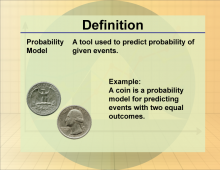
|
Definition--Statistics and Probability Concepts--Probability Model | Probability ModelTopicStatistics and Probability DefinitionA probability model is a mathematical representation of a random phenomenon. DescriptionProbability models are essential in understanding how to quantify uncertainty in various scenarios. They can be as simple as a coin toss or as complex as predicting stock market trends. These models usually incorporate the outcomes of an event and their associated probabilities. |
Probability |
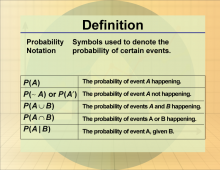
|
Definition--Statistics and Probability Concepts--Probability Notation | Probability NotationTopicStatistics and Probability DefinitionProbability notation is a standardized way of expressing probabilities. DescriptionProbability notation provides a concise language for defining and communicating probabilities in mathematics. It helps in avoiding confusion in statistical communication. Common symbols include P(A) for the probability of event A occurring. |
Data Analysis |
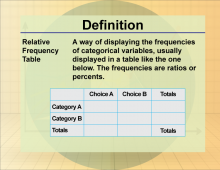
|
Definition--Statistics and Probability Concepts--Relative Frequency Table | Relative Frequency TableTopicStatistics and Probability DefinitionA relative frequency table displays the proportion of total occurrences for each category of data. DescriptionRelative frequency tables are important in statistics as they summarize data in a way that makes it easy to analyze proportions and patterns within datasets. These tables allow for quick comparisons of different categories based on their frequency relative to the total. |
Data Analysis |
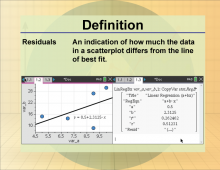
|
Definition--Statistics and Probability Concepts--Residuals | ResidualsTopicStatistics and Probability DefinitionResiduals are the differences between observed and predicted values in a dataset. DescriptionIn statistics, residuals are crucial for assessing the accuracy of predictions generated by statistical models. They represent the errors in prediction, providing insight into the model's performance and areas for potential improvement. |
Data Analysis |

|
Definition--Statistics and Probability Concepts--Two-Way Frequency Table | Two-Way Frequency TableTopicStatistics and Probability DefinitionA two-way frequency table displays the frequency of data points across two categorical variables. DescriptionTwo-way frequency tables are essential for analyzing the relationship between two categorical variables, often used in survey analysis to explore associations between different demographic factors. They help in identifying patterns and correlations within datasets. |
Data Analysis |
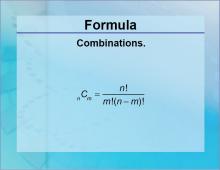
|
Formulas--Combinatons | Formulas--Combinatons
The formula for Combinations. This is part of a collection of math formulas. To see the complete collection of formulas, click on this link. Note: The download is a JPG file.Related ResourcesTo see resources related to this topic click on the Related Resources tab above. |
Probability |
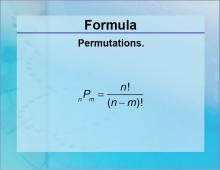
|
Formulas--Permutations | Formulas--Permutations
The formula for Permutations. This is part of a collection of math formulas. To see the complete collection of formulas, click on this link. Note: The download is a JPG file.Related ResourcesTo see resources related to this topic click on the Related Resources tab above. |
Probability |
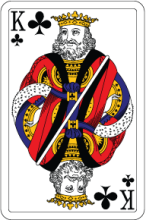
|
Instructional Resource: Tutorial: Probability and Playing Cards, Lesson 5: Playing Poker | Instructional Resource: Tutorial: Probability and Playing Cards, Lesson 5
In this tutorial, learn about the permutations and combinations involved in calculating card arrangements. This lesson calculates the probabilities of getting a pair of cards on the first draw. A card simulator is used. —Click on Preview to see the tutorial— |
Probability and Combinatorics |

|
INSTRUCTIONAL RESOURCE: Math Examples 39 | INSTRUCTIONAL RESOURCE: Math Examples--Probability
This set of tutorials provides 28 examples of how to solve probability problems. This is part of a collection of math examples for a variety of math topics. To see the complete collection of these resources, click on this link. Note: The download is a PPT file.Library of Instructional ResourcesTo see the complete library of Instructional Resources , click on this link. |
Probability |

|
Instructional Resource: Tutorial: Geometric Probability | INSTRUCTIONAL RESOURCE: Tutorial: Geometric Probability
This tutorial provides an overview of geometric probability. This is part of a collection of math tutorials on a variety of math topics. To see the complete collection of these resources, click on this link.Library of Instructional ResourcesTo see the complete library of Instructional Resources , click on this link. |
Probability |
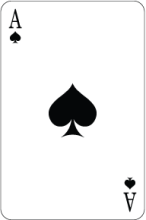
|
Instructional Resource: Tutorial: Probability and Playing Cards, Lesson 1 | Instructional Resource: Tutorial: Probability and Playing Cards, Lesson 1
In this tutorial, learn about the probability of drawing a specific card from a deck of 52 cards. You will also use a simulation of a deck of cards to run probability experiments. —Click on Preview to see the tutorial— |
Probability |
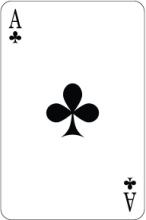
|
Instructional Resource: Tutorial: Probability and Playing Cards, Lesson 2 | Instructional Resource: Tutorial: Probability and Playing Cards, Lesson 2
In this tutorial, learn about the probability of drawing a specific card from a deck of 52 cards. You will also use a simulation of a deck of cards to run probability experiments. In this lesson look at probabilities involving card group, as well as probabilities involving AND and OR. —Click on Preview to see the tutorial— |
Probability |
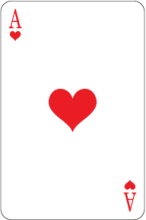
|
Instructional Resource: Tutorial: Probability and Playing Cards, Lesson 3: Pocket Aces | Instructional Resource: Tutorial: Probability and Playing Cards, Lesson 3
In this tutorial, learn about the probability of drawing two aces consecutively from a deck of 52 cards. You will also use a simulation of a deck of cards to run probability experiments. This lesson covers dependent events and compound probability. —Click on Preview to see the tutorial— |
Probability |

|
Math Clip Art--Dice and Number Models--Single Die with 1 Showing | Math Clip Art--Dice and Number Models--Single Die with 1 ShowingTopicProbability and Statistics DescriptionThis image is part of a series that illustrates various dice and number models used in mathematics education. The specific content of this image, as indicated by its title, shows a single die with the number 1 facing up. This simple yet effective visual aid is crucial for introducing basic concepts of probability and statistics. |
Probability |
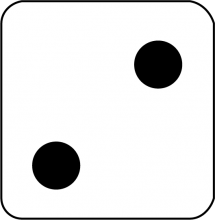
|
Math Clip Art--Dice and Number Models--Single Die with 2 Showing | Math Clip Art--Dice and Number Models--Single Die with 2 ShowingTopicProbability and Statistics DescriptionThis image is part of a comprehensive series showcasing dice and various number models used in mathematics education. The specific content of this image, as indicated by its title, displays a single die with the number 2 facing up. This visual representation is an essential tool for teaching fundamental concepts in probability and statistics. |
Probability |
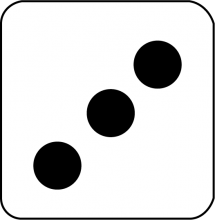
|
Math Clip Art--Dice and Number Models--Single Die with 3 Showing | Math Clip Art--Dice and Number Models--Single Die with 3 ShowingTopicProbability and Statistics DescriptionThis image is part of an extensive series showcasing dice and various number models used in mathematics education. The specific content of this image, as indicated by its title, presents a single die with the number 3 facing up. This visual aid is a valuable tool for teaching key concepts in probability and statistics. |
Probability |

|
Math Clip Art--Dice and Number Models--Single Die with 4 Showing | Math Clip Art--Dice and Number Models--Single Die with 4 ShowingTopicProbability and Statistics DescriptionThis image is part of a comprehensive series showcasing dice and various number models used in mathematics education. The specific content of this image, as indicated by its title, displays a single die with the number 4 facing up. This visual representation serves as an excellent tool for teaching fundamental concepts in probability and statistics. |
Probability |
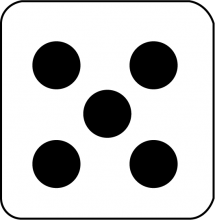
|
Math Clip Art--Dice and Number Models--Single Die with 5 Showing | Math Clip Art--Dice and Number Models--Single Die with 5 ShowingTopicProbability and Statistics DescriptionThis image is part of a comprehensive series showcasing dice and various number models used in mathematics education. The specific content of this image, as indicated by its title, presents a single die with the number 5 facing up. This visual aid is an essential tool for teaching fundamental concepts in probability and statistics. |
Probability |
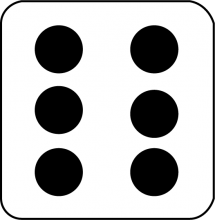
|
Math Clip Art--Dice and Number Models--Single Die with 6 Showing | Math Clip Art--Dice and Number Models--Single Die with 6 ShowingTopicProbability and Statistics DescriptionThis image is part of an extensive series showcasing dice and various number models used in mathematics education. The specific content of this image, as indicated by its title, displays a single die with the number 6 facing up. This visual representation serves as a valuable tool for teaching key concepts in probability and statistics. |
Probability |

|
Math Clip Art--Dice and Number Models--Two Dice with 10 Showing, A | Math Clip Art--Dice and Number Models--Two Dice with 10 Showing, ATopicProbability and Statistics DescriptionThis image is part of a comprehensive series showcasing dice and various number models used in mathematics education. The specific content of this image, as indicated by its title, presents two dice with a total of 10 showing. This visual aid is an essential tool for teaching advanced concepts in probability and statistics, particularly when dealing with multiple events. |
Probability |

|
Math Clip Art--Dice and Number Models--Two Dice with 10 Showing, B | Math Clip Art--Dice and Number Models--Two Dice with 10 Showing, BTopicProbability and Statistics DescriptionThis image is part of an extensive series showcasing dice and various number models used in mathematics education. The specific content of this image, as indicated by its title, displays two dice with a total of 10 showing, but in a different combination from the previous image. This visual representation serves as a valuable tool for teaching advanced concepts in probability and statistics, particularly when dealing with multiple events and different combinations yielding the same sum. |
Probability |

|
Math Clip Art--Dice and Number Models--Two Dice with 11 Showing | Math Clip Art--Dice and Number Models--Two Dice with 11 ShowingTopicProbability and Statistics DescriptionThis image is part of a comprehensive series showcasing dice and various number models used in mathematics education. The specific content of this image, as indicated by its title, presents two dice with a total of 11 showing. This visual aid is an essential tool for teaching advanced concepts in probability and statistics, particularly when dealing with multiple events and sums close to the maximum possible outcome. |
Probability |

|
Math Clip Art--Dice and Number Models--Two Dice with 12 Showing | Math Clip Art--Dice and Number Models--Two Dice with 12 ShowingTopicProbability and Statistics DescriptionThis image is part of an extensive series showcasing dice and various number models used in mathematics education. The specific content of this image, as indicated by its title, displays two dice with a total of 12 showing. This visual representation serves as a valuable tool for teaching advanced concepts in probability and statistics, particularly when dealing with multiple events and the maximum possible outcome. |
Probability |

|
Math Clip Art--Dice and Number Models--Two Dice with 2 Showing | Math Clip Art--Dice and Number Models--Two Dice with 2 ShowingTopicProbability and Statistics DescriptionThis image is part of a comprehensive series showcasing dice and various number models used in mathematics education. The specific content of this image, as indicated by its title, presents two dice with a total of 2 showing. This visual aid is an essential tool for teaching advanced concepts in probability and statistics, particularly when dealing with multiple events and the minimum possible outcome. |
Probability |

|
Math Clip Art--Dice and Number Models--Two Dice with 3 Showing | Math Clip Art--Dice and Number Models--Two Dice with 3 ShowingTopicProbability and Statistics DescriptionThis image is part of a comprehensive series showcasing dice and various number models used in mathematics education. The specific content of this image, as indicated by its title, presents two dice with a total of 3 showing. This visual aid is an essential tool for teaching fundamental concepts in probability and statistics, particularly when dealing with multiple events and the minimum possible outcome. |
Probability |

|
Math Clip Art--Dice and Number Models--Two Dice with 4 Showing, A | Math Clip Art--Dice and Number Models--Two Dice with 4 Showing, ATopicProbability and Statistics DescriptionThis image is part of an extensive series showcasing dice and various number models used in mathematics education. The specific content of this image, as indicated by its title, displays two dice with a total of 4 showing. This visual representation serves as a valuable tool for teaching key concepts in probability and statistics, particularly when dealing with multiple events and different combinations yielding the same sum. |
Probability |